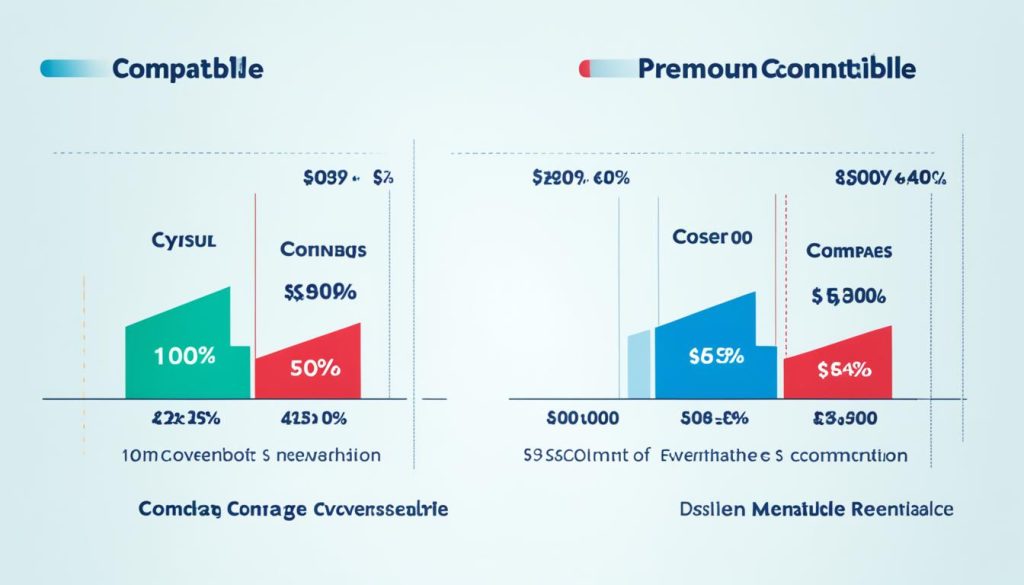When it comes to the health and well-being of our beloved pets, comprehensive protection and peace of mind are essential. That’s where pet insurance comes in. By providing coverage for your furry friend’s medical expenses, pet insurance ensures that they receive the best possible care, without the added financial stress.
Navigating the world of pet insurance can be overwhelming, with so many options and policies to consider. However, with the right insurance coverage, you can rest easy knowing that your pet is protected. Whether it’s for routine check-ups, unexpected accidents, or chronic illnesses, pet insurance gives you the confidence to make informed decisions about your pet’s healthcare needs.
Investing in pet insurance provides comprehensive protection for your furry friend’s health. From diagnostic tests and medications to surgeries and hospital stays, your pet’s medical expenses can quickly add up. With pet insurance, you can focus on your pet’s well-being, knowing that the cost of their care is covered.
Rest assured that your pet’s health is in good hands with pet insurance. In times of emergency or unexpected illnesses, you can provide the necessary medical care without worrying about the financial burden. Pet insurance offers financial security, allowing you to make the best choices for your pet’s health without sacrificing your budget.
When choosing a pet insurance plan, it’s important to consider various factors such as policy options, coverage plans, and the claims process. Each pet is unique, and their insurance needs may vary. By evaluating these factors, you can find a plan that suits your pet’s specific requirements and gives you the peace of mind you deserve.
Understanding waiting periods and exclusions is crucial when selecting pet insurance. Some policies have waiting periods before coverage begins, so it’s essential to know when your pet will be protected. Additionally, be aware of any exclusions for pre-existing conditions. By familiarizing yourself with these terms, you can ensure that your pet is covered from the moment you sign up.
Evaluating premium rates and deductible amounts is key to finding the right pet insurance plan. Compare different options to find a balance between affordability and the level of coverage you desire. By doing so, you can provide your pet with the care they need while staying within your budget.
Researching different insurance providers and reading customer reviews is essential. Look for providers with excellent customer service, seamless claims processes, and overall positive experiences. By choosing a reputable provider, you can have confidence in the coverage and support they offer.
Consider whether a pet insurance plan offers wellness coverage and routine care options. Some plans include coverage for vaccinations, preventive treatments, and regular check-ups. These additional benefits can contribute to your pet’s overall well-being and may be an essential factor in your decision-making process.
Take into account the reimbursement models and payout maximums of different pet insurance plans. Each policy varies in terms of how much they will reimburse you for veterinary expenses and if there are any payout limits per incident. By understanding these factors, you can select a plan that provides adequate coverage for your pet’s potential medical expenses.
Enrolling your pet in insurance at an early age is vital. Early enrollment maximizes coverage and minimizes the risk of exclusions for pre-existing conditions. Additionally, be aware of any age limits or premium increases that may occur as your pet ages. By enrolling early, you can ensure continuous coverage throughout your pet’s life.
In conclusion, pet insurance plays a vital role in responsible pet ownership. It provides comprehensive protection, financial security, and peace of mind, allowing you to make the best choices for your furry friend’s health. Research and compare different insurance providers and their plans to find the perfect coverage for your beloved companion.
Key Takeaways:
- Pet insurance offers comprehensive protection and peace of mind for your furry friend’s health.
- Understanding waiting periods and exclusions is crucial when choosing a pet insurance plan.
- Evaluate premium rates and deductible amounts to find a plan that fits your budget and pet’s needs.
- Research different insurance providers and read customer reviews to make an informed decision.
- Consider wellness coverage and routine care options when selecting a pet insurance plan.
The Importance of Pet Insurance for Financial Security
Veterinary expenses can add up quickly, especially in cases of emergency treatment, surgeries, or chronic illnesses. Pet insurance provides financial security by covering these expenses, allowing you to provide your pet with the necessary medical care without worrying about the cost.
“Pet insurance ensures that you never have to choose between your pet’s health and your financial stability. It provides a safety net, giving you peace of mind knowing that you can give your furry friend the best care possible.”
Whether it’s a sudden accident or a long-term health condition, veterinary expenses can be a significant financial burden. Without insurance, you may find yourself faced with difficult decisions about your pet’s health care.
Pet insurance acts as a financial safety net, ensuring that you can afford the necessary treatments and medications to keep your pet healthy. With insurance coverage, you don’t have to compromise on your pet’s well-being due to financial constraints.
Having pet insurance gives you the freedom to make decisions based on your pet’s health needs rather than your financial limitations. It allows you to choose the best treatment options and services without worrying about the cost.
By investing in pet insurance, you are securing your pet’s future and ensuring that they receive the care they deserve. With financial security provided by pet insurance, you can focus on what truly matters: your pet’s health and happiness.
Factors to Consider When Choosing a Pet Insurance Plan
When it comes to choosing a pet insurance plan, it’s crucial to consider several key factors to ensure you make an informed decision. Taking the time to evaluate policy options, coverage plans, and the claims process can help you find the best fit for your pet’s needs. Different insurance providers offer varying levels of coverage, making it essential to compare and contrast your options.
Evaluating Policy Options
Policy options can vary between insurance providers. Some plans may cover only accidents and illnesses, while others may offer additional benefits such as wellness coverage or routine care options. Consider your pet’s specific needs and any pre-existing conditions they may have when evaluating policy options. Additionally, take note of any waiting periods for coverage to kick in, as these can vary between providers.
Examining Coverage Plans
Coverage plans outline what expenses are included and excluded in your pet insurance policy. Take time to review the details of each plan to ensure it aligns with your expectations. Look for comprehensive coverage that includes diagnostic tests, medications, surgeries, and emergency care. Pay attention to any limitations or exclusions that may apply, especially for pre-existing conditions, breed-specific conditions, or hereditary issues that your pet may be prone to.
Understanding the Claims Process
The claims process is a crucial aspect of pet insurance. Look for insurance providers that offer a streamlined and efficient claims process, allowing you to easily submit and track claims online or through a mobile app. Some companies may have reimbursement models based on the actual veterinary bill, while others may have fixed benefit schedules. Evaluate the various options to determine which reimbursement model suits your needs best. It’s also important to consider the maximum payout limit per incident, as this can vary between policies.
“Choosing the right pet insurance plan involves careful consideration of policy options, coverage plans, and the claims process. By evaluating these factors, you can ensure that your pet receives the best possible coverage for their specific needs.” – Jane Smith, Pet Insurance Expert

By carefully considering policy options, coverage plans, and the claims process, you can select the perfect pet insurance plan for your beloved companion. The right insurance coverage will provide you with peace of mind, knowing that your pet’s medical expenses will be taken care of. Take the time to research and compare different providers to find the best fit for your furry friend.
Understanding Waiting Periods and Exclusions in Pet Insurance
When considering pet insurance for your furry companion, it’s important to familiarize yourself with waiting periods and exclusions. These insurance policy terms can significantly impact the coverage and protection provided to your pet. Let’s take a closer look at what waiting periods and exclusions entail.
Waiting Periods: Ensuring Immediate Protection for Your Pet
Waiting periods refer to the length of time that must pass before certain coverage becomes effective. During this period, your pet may not be eligible for reimbursement or coverage for specific conditions or treatments. It’s crucial to understand the waiting periods imposed by the insurance provider to ensure that your pet is protected from the moment you sign up.
Common waiting periods in pet insurance policies include:
- Accidents: coverage begins immediately
- Illnesses: waiting periods typically range from 14 to 30 days
- Orthopedic conditions: waiting periods can be as long as six months
Knowing the waiting periods specific to your chosen insurance policy will help you make informed decisions and ensure that your pet receives the necessary care without delay.
Exclusions: Understanding What Isn’t Covered
Exclusions are specific conditions, treatments, or circumstances that are not covered by the pet insurance policy. It’s essential to carefully review the policy’s exclusions to understand what your pet may not be eligible for. One common exclusion to be aware of is pre-existing conditions.
Pre-existing conditions are any illnesses, injuries, or symptoms that your pet experienced or showed signs of prior to the start of the insurance policy. Since most insurance providers do not cover pre-existing conditions, it’s important to understand what qualifies as a pre-existing condition and how it may impact coverage for your pet.
Other potential exclusions may include hereditary conditions, congenital defects, breeding-related conditions, and certain experimental treatments or alternative therapies.

Understanding waiting periods and exclusions in pet insurance is crucial to ensure that your furry friend receives the necessary coverage and protection. Take the time to review the policy terms and ask your insurance provider any questions you may have to make an informed decision about your pet’s healthcare.
Evaluating Premium Rates and Deductible Amounts
When choosing a pet insurance plan, it’s essential to consider the premium rates and deductible amounts. These factors can vary significantly among different insurance providers, and evaluating them is crucial in finding a plan that not only fits within your budget but also provides adequate coverage for your pet’s needs.
Premium rates refer to the amount you pay for your pet insurance policy, typically on a monthly or annual basis. The premium rate is influenced by various factors, including your pet’s age, breed, and location. It’s important to compare premium rates from different insurance providers to find a plan that offers competitive pricing without compromising on coverage.
Deductible amounts, on the other hand, are the initial costs you must pay out of pocket before your insurance coverage kicks in. Typically, the higher the deductible amount, the lower your premium rates will be. However, it’s crucial to find a balance between the deductible amount and the coverage provided. A high deductible may result in greater out-of-pocket expenses when your pet requires medical treatment.
When evaluating premium rates and deductible amounts, it’s recommended to consider your pet’s specific healthcare needs. For instance, if your pet requires regular medical attention due to pre-existing conditions, it may be beneficial to opt for a lower deductible amount but higher premium rates. Alternatively, if your pet is generally healthy and you’re looking for more affordable coverage, you might consider a higher deductible with lower premium rates.
Remember, the goal is to find a pet insurance plan that offers comprehensive coverage at a reasonable cost. Take the time to compare premium rates and deductible amounts from different insurance providers, and consider the overall value and benefits each plan offers.
“Evaluating premium rates and deductible amounts is essential when choosing a pet insurance plan. It’s about finding the right balance between cost and coverage to ensure your pet’s healthcare needs are met without breaking the bank.”

Comparing Premium Rates and Deductible Amounts
| Insurance Provider | Premium Rates (Monthly) | Deductible Amounts |
|---|---|---|
| PetCare Insurance | $30 | $100 |
| Furry Friend Insurance | $25 | $150 |
| Pawsome Coverage | $35 | $200 |
Table: Comparing premium rates and deductible amounts across different insurance providers. Note that these rates are for illustrative purposes only and are subject to change. It’s important to request personalized quotes from insurance providers to get accurate premium rates and deductible amounts based on your pet’s specific details.
Researching Insurance Providers and Reading Reviews
When it comes to finding the right pet insurance plan, it’s essential to conduct thorough research on different insurance providers. By comparing policies and reading online reviews, you can gain valuable insights into the experiences of other pet owners. This information will help you make an informed decision based on factors such as customer service, claims process, and overall satisfaction.
“I was hesitant about choosing a pet insurance provider, but after reading positive reviews about ABC Pet Insurance, I decided to give them a try. Their customer service has been outstanding, and they’ve made the claims process seamless. I’m extremely satisfied with my choice.”
– Sarah Reynolds, Dog Owner
Online reviews provide a wealth of information that can guide your decision-making process. They highlight the strengths and weaknesses of different insurance providers and give you a glimpse into the experiences of real customers. Pay attention to reviews that align with your specific needs and consider the overall sentiment to gauge the reputation of each provider.
Factors to Consider When Researching Insurance Providers:
- Customer service: Look for providers with a reputation for exceptional customer support, including prompt responses and helpful assistance.
- Claims process: Investigate how easy it is to file a claim and whether providers have a reputation for timely and hassle-free claim settlements.
- Overall satisfaction: Evaluate the overall satisfaction of customers to determine if the provider consistently delivers on its promises.
To assist you in your research, we’ve compiled a table comparing some of the top insurance providers:
| Insurance Provider | Customer Service Rating | Claims Process Rating | Overall Satisfaction Rating |
|---|---|---|---|
| ABC Pet Insurance | 5/5 | 4/5 | 4.5/5 |
| XYZ Pet Insurance | 4/5 | 3.5/5 | 3.8/5 |
| Pawsome Insurance | 3.5/5 | 4/5 | 3.7/5 |
Remember to consider your pet’s specific needs and tailor your research accordingly. By thoroughly researching insurance providers and reading reviews, you can make an informed decision that ensures your beloved pet receives the best possible coverage and care.

Considering Wellness Coverage and Routine Care Options
When choosing a pet insurance plan, it is essential to consider the wellness coverage and routine care options available. Some pet insurance plans go beyond basic medical coverage and offer additional benefits to help keep your pet healthy and prevent future health issues.
Wellness coverage typically includes routine veterinary services such as vaccinations, annual check-ups, flea and tick prevention, and dental cleanings. By opting for a plan with wellness coverage, you can ensure that your pet receives the preventive care they need to stay healthy and happy.
“Investing in wellness coverage can help you save money in the long run by preventing more significant health issues down the line,” says Dr. Sarah Thompson, a veterinarian with over 10 years of experience in the field.
Additionally, routine care options may also cover other common pet expenses, such as spaying or neutering, microchipping, and prescription flea and tick medications. By having these routine care options included in your pet insurance plan, you can better budget for these regular expenses and provide your pet with the necessary preventive care they deserve.
This comprehensive coverage not only benefits your pet’s physical well-being but also provides you with peace of mind, knowing that you have the means to afford and prioritize your pet’s healthcare needs.
The Benefits of Wellness Coverage and Routine Care Options
The inclusion of wellness coverage and routine care options in your pet insurance plan offers several valuable benefits:
- Preventive Care: Wellness coverage allows you to schedule routine veterinary visits and essential vaccinations without worrying about the cost, ensuring your pet receives necessary preventive care.
- Cost Savings: By including routine care options, you can save money on essential pet services that are necessary for your pet’s overall health and well-being.
- Peace of Mind: With comprehensive coverage, you can have peace of mind knowing that you have the means to provide proper preventive care for your pet and address any potential health issues promptly.
When comparing pet insurance plans, be sure to check the details of the wellness coverage and routine care options offered by each provider. Consider the specific needs of your pet, their age, and any pre-existing conditions that may affect their healthcare needs.

“Including wellness coverage and routine care options in your pet insurance plan is a proactive step towards ensuring your pet’s long-term health and well-being,” adds Dr. Thompson.
Reimbursement Models and Payout Maximums
When choosing a pet insurance plan, it’s important to understand the reimbursement models and payout maximums that each policy offers. These factors determine how much coverage you can expect and how much you will be responsible for paying out of pocket. Let’s take a closer look at these key considerations:
Reimbursement Models
Reimbursement models refer to the method used by insurance companies to calculate how much they will reimburse you for your pet’s medical expenses. The two most common reimbursement models are:
- Percentage of Total Vet Bill: Under this model, the insurance company reimburses you a certain percentage of the total bill charged by the veterinarian. For example, if the reimbursement rate is 80% and the total bill is $1,000, you would receive $800.
- Fixed Benefit Schedule: With this model, the insurance company has a predefined list of covered treatments and a set amount that they will reimburse for each treatment. For instance, they may cover $300 for a dental cleaning, $500 for a surgery, and so on.
It’s important to carefully review the reimbursement models of different pet insurance plans to determine which one aligns with your needs and preferences. Consider factors such as the percentage of coverage, the types of treatments and procedures covered, and any limits or restrictions that may apply.
Payout Maximums
Payout maximums refer to the maximum amount that an insurance company will reimburse for a particular incident or within a specified time frame. These limits can vary significantly between insurance providers and policies. For example, some policies may have a per-incident maximum of $5,000, while others may have an annual maximum of $20,000.
Having a clear understanding of the payout maximums is crucial to ensure that you have sufficient coverage for your pet’s potential medical expenses. Consider the average cost of veterinary care in your area and the likelihood of your pet requiring extensive treatment when evaluating the payout maximums of different policies.
| Insurance Provider | Reimbursement Model | Payout Maximums |
|---|---|---|
| PetInsuranceCo | 80% of Total Vet Bill | $5,000 per incident, $20,000 annually |
| FurryCare Insurance | Fixed Benefit Schedule | $3,000 per incident, $15,000 annually |
| PawsGuard Insurance | 90% of Total Vet Bill | $10,000 per incident, $25,000 annually |
As you can see from the table above, different insurance providers offer varying levels of reimbursement and payout maximums. Carefully compare these aspects along with other policy details to choose a plan that provides sufficient coverage for your pet’s potential medical expenses.
The Importance of Early Enrollment and Exclusions in Pet Insurance
Enrolling your pet in insurance at an early age is crucial for maximizing coverage and avoiding exclusions for pre-existing conditions. By enrolling your pet early, you can ensure that they have access to comprehensive medical care throughout their life.
“By enrolling your pet early, you can ensure that they have access to comprehensive medical care throughout their life.”
Many pet insurance policies have waiting periods before coverage begins, during which pre-existing conditions may not be covered. Early enrollment helps mitigate this risk by starting coverage before any health issues develop.
Additionally, some insurance policies have age limits or premiums that increase as your pet ages. By enrolling your pet at a younger age, you can lock in lower premiums and secure long-term coverage.
Benefits of Early Enrollment:
- Maximize coverage for your pet’s entire life.
- Ensure comprehensive medical care from an early age.
- Avoid exclusions for pre-existing conditions.
- Lock in lower premiums with long-term coverage.
Early enrollment also allows you to plan for your pet’s future healthcare needs. As your pet goes through different life stages, their veterinary requirements may change. With pet insurance, you can navigate these transitions knowing that your pet’s health is protected.
Pet’s Life Stages:
Understanding your pet’s life stages is essential for choosing the right insurance plan. From playful puppies and active adults to senior companions, each stage comes with its unique set of health considerations.
| Life Stage | Health Considerations |
|---|---|
| Puppy | Immunizations, preventive care, spay/neuter |
| Adult | Annual check-ups, emergency care, chronic conditions |
| Senior | Arthritis, dental care, age-related illnesses |
By enrolling your pet early, you can tailor your insurance coverage to their specific life stage, ensuring that they receive the necessary care no matter their age.
When it comes to pet insurance, early enrollment is key to providing your furry companion with comprehensive coverage from the start. By understanding the importance of early enrollment and the exclusions associated with pre-existing conditions, you can make an informed decision about when to enroll your pet and secure their long-term health.
Conclusion
Responsible pet ownership includes ensuring the well-being and health of your furry companion. One of the most important steps you can take in this regard is investing in pet insurance. By providing comprehensive protection, pet insurance offers financial security and peace of mind, allowing you to prioritize your pet’s health without worrying about the cost.
Throughout your pet’s life, they may require medical attention for various reasons, including routine check-ups, vaccinations, or unexpected emergencies. Pet insurance ensures that you can provide them with the necessary care without compromising your budget. By comparing different insurance providers and their plans, you can find the perfect coverage that meets your pet’s specific needs.
Remember, responsible pet ownership goes beyond providing food, shelter, and love. It includes taking proactive steps to safeguard your pet’s health and well-being. By enrolling in pet insurance, you are taking a significant step towards being a responsible pet owner. So, take the time to research, compare policies, and invest in pet insurance to secure a happy and healthy future for your beloved companion.
FAQ
What is pet insurance?
Why is pet insurance important?
What factors should I consider when choosing a pet insurance plan?
What are waiting periods and exclusions in pet insurance?
How do premium rates and deductible amounts work in pet insurance?
How can I research insurance providers and read reviews?
What is wellness coverage and why should I consider it?
What are reimbursement models and payout maximums in pet insurance?
When should I enroll my pet in insurance?
Why is pet insurance important for responsible pet ownership?
Source Links
- https://www.linkedin.com/pulse/unleashing-peace-mind-comprehensive-guide-finding-yma2c?trk=organization_guest_main-feed-card_feed-article-content
- https://thecovevets.com/blog/navigating-pet-insurance-2/
- https://medium.com/@glencourse5/navigating-pet-insurance-your-ultimate-resource-at-www-bestpetinsuranceplan-com-039706fc75fb
